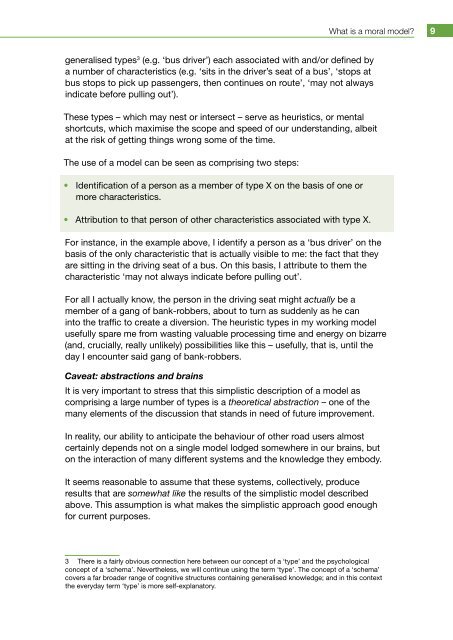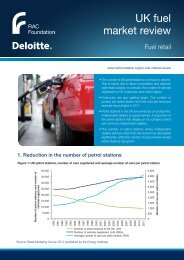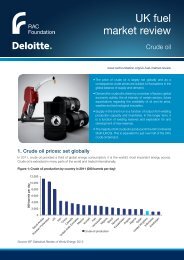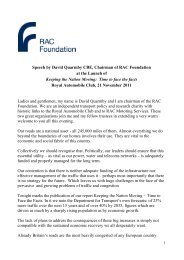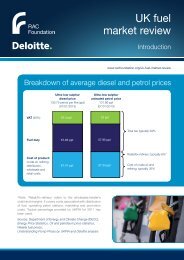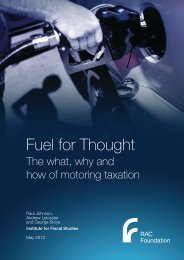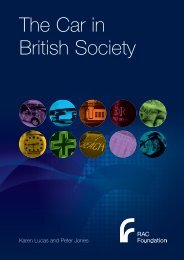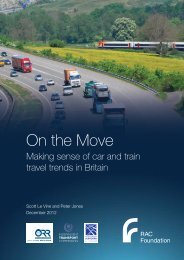Road sharing - does it matter what road users think of each other?
Road sharing - does it matter what road users think of each other?
Road sharing - does it matter what road users think of each other?
You also want an ePaper? Increase the reach of your titles
YUMPU automatically turns print PDFs into web optimized ePapers that Google loves.
What is a moral model?9generalised types 3 (e.g. ‘bus driver’) <strong>each</strong> associated w<strong>it</strong>h and/or defined bya number <strong>of</strong> characteristics (e.g. ‘s<strong>it</strong>s in the driver’s seat <strong>of</strong> a bus’, ‘stops atbus stops to pick up passengers, then continues on route’, ‘may not alwaysindicate before pulling out’).These types – which may nest or intersect – serve as heuristics, or mentalshortcuts, which maximise the scope and speed <strong>of</strong> our understanding, albe<strong>it</strong>at the risk <strong>of</strong> getting things wrong some <strong>of</strong> the time.The use <strong>of</strong> a model can be seen as comprising two steps:• Identification <strong>of</strong> a person as a member <strong>of</strong> type X on the basis <strong>of</strong> one ormore characteristics.• Attribution to that person <strong>of</strong> <strong>other</strong> characteristics associated w<strong>it</strong>h type X.For instance, in the example above, I identify a person as a ‘bus driver’ on thebasis <strong>of</strong> the only characteristic that is actually visible to me: the fact that theyare s<strong>it</strong>ting in the driving seat <strong>of</strong> a bus. On this basis, I attribute to them thecharacteristic ‘may not always indicate before pulling out’.For all I actually know, the person in the driving seat might actually be amember <strong>of</strong> a gang <strong>of</strong> bank-robbers, about to turn as suddenly as he caninto the traffic to create a diversion. The heuristic types in my working modelusefully spare me from wasting valuable processing time and energy on bizarre(and, crucially, really unlikely) possibil<strong>it</strong>ies like this – usefully, that is, until theday I encounter said gang <strong>of</strong> bank-robbers.Caveat: abstractions and brainsIt is very important to stress that this simplistic description <strong>of</strong> a model ascomprising a large number <strong>of</strong> types is a theoretical abstraction – one <strong>of</strong> themany elements <strong>of</strong> the discussion that stands in need <strong>of</strong> future improvement.In real<strong>it</strong>y, our abil<strong>it</strong>y to anticipate the behaviour <strong>of</strong> <strong>other</strong> <strong>road</strong> <strong>users</strong> almostcertainly depends not on a single model lodged somewhere in our brains, buton the interaction <strong>of</strong> many different systems and the knowledge they embody.It seems reasonable to assume that these systems, collectively, produceresults that are some<strong>what</strong> like the results <strong>of</strong> the simplistic model describedabove. This assumption is <strong>what</strong> makes the simplistic approach good enoughfor current purposes.3 There is a fairly obvious connection here between our concept <strong>of</strong> a ‘type’ and the psychologicalconcept <strong>of</strong> a ‘schema’. Nevertheless, we will continue using the term ‘type’. The concept <strong>of</strong> a ‘schema’covers a far b<strong>road</strong>er range <strong>of</strong> cogn<strong>it</strong>ive structures containing generalised knowledge; and in this contextthe everyday term ‘type’ is more self-explanatory.


